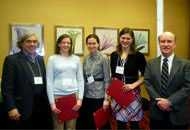The MIT Energy Initiative (MITEI) has announced its latest round of seed grants to support early-stage innovative energy projects. This year’s winners address a wide range of topics including energy efficiency, new materials, thermal imaging, rock fracturing, efficient irrigation and integration of renewables into the smart grid.
A total of more than $2 million was awarded to 14 projects, each lasting up to two years. The funded projects span all five of MIT’s schools.
As in the past, the call for proposals welcomed submissions on any energy-related topic, but this time, MITEI’s industry sponsors particularly encouraged projects focusing on end-use efficiency. In response to the call, MITEI received a total of 44 proposals, 17 of which focused on reducing energy use in buildings and industrial processes.
Six of these efficiency-related proposals were funded. In one example, Associate Professor Nicolas Hadjiconstantinou and Assistant Professor Rohit Karnik of mechanical engineering are designing and developing novel nanoporous graphene membranes for gas separation. The use of graphene opens a new frontier in the field of separation because it forms a flat sheet just one atom thick. Graphene membranes are expected to have very high permeance, which translates directly into high energy efficiency, as well as a high degree of selectivity through size exclusion. The researchers will focus initially on separating methane from hydrogen, which is important for natural gas processing. Their approach can be extended to other applications related to carbon dioxide sequestration, oxy-combustion and syngas production.
In another project, Assistant Professor Mircea Dinca of chemistry is developing a new class of crystalline microporous heterogeneous catalysts that are expected to affect industrially relevant catalytic transformations. The proposed materials — called metal-organic metallosilicates, or MOMs — display highly regular pores whose surfaces can be engineered at an atomic level, providing the size, shape and chemical selectivity required for energy efficient and environmentally responsible catalytic transformations. The synthesis of new materials that are tunable in the nanoporous regime is essential for improving the energy efficiency of bulk and fine chemical production.
Professor Sanjay Sarma of mechanical engineering and his colleagues in MIT’s Field Intelligence Laboratory will further develop their high-resolution scanning thermal imaging system for detecting energy leaks in buildings. Energy consumption for heating and cooling buildings constitutes more than 10 percent of total U.S. energy demand. Identifying energy leaks so that proper sealing and insulation can be installed could thus yield significant energy savings. The researchers’ novel approach to scanning buildings while driving through neighborhoods overcomes significant challenges in long-wave infrared (IR) thermography, from the cost of the cameras to poor resolution and from the effective use of IR optics to scanning while in motion.
Other funded projects address various energy-related issues outside the efficiency category. For example, the increasing demand for electricity coupled with environmental concerns has produced a need for smart power grids that can integrate vast amounts of electricity from renewable sources. But renewable sources are intermittent and uncertain, leading to a greater need for backup reserves and rapid ramping ability to ensure grid stability. Professor Munther Dahleh of electrical engineering and computer science is examining the interplay between storage and renewables — specifically, defining and analyzing market mechanisms involving storage, quantifying the benefits of investment in storage capacities, and designing and implementing energy management algorithms that can be used to maximize the value from renewable generation using storage.
Another project is examining rock fracture processes, with a focus on induced seismicity in enhanced (engineered) geothermal systems (EGS). Hydraulic fracturing is well established as a technique for stimulating oil and gas extraction, but its use with EGS raises new concerns, including the possibility of induced seismicity. Professor Herbert Einstein and Senior Research Associate John Germaine of civil and environmental engineering are attempting to determine whether EGS conditions produce fracturing processes that differ from those that occur during oil and gas production. The researchers will investigate fracturing processes in the laboratory and will use their results as the basis for scaling up analytical models, thereby producing tools that can better predict the impacts of EGS stimulation.
In her project, Associate Professor Jing Kong of electrical engineering and computer science plans to develop a variety of novel aerogels — porous solid materials with ultra-high surface area, low bulk densities, and low thermal conductivities. Aerogels have potential uses in catalysis, sensing, energy storage, solar cells, fuel cells, thermal insulation, ultra-light structural media, and other energy-related applications. Despite the considerable need, at present there are only limited types of materials that can be made in the aerogel structure. Kong and her research team have recently developed a new method of making gels that they will use to fabricate novel aerogel materials, with a special focus on materials tailored for use in supercapacitors.
Another funded project will focus on linkages between water use efficiency and energy intensity in large-scale irrigation systems. The agricultural sector is responsible for 70 percent of global freshwater use, and that sector is likewise dependent on electric power for pumping. Professor James Wescoat of architecture and Research Scientist Afreen Siddiqi of the Engineering Systems Division will produce a scalable analytical framework to take into account uncertainties associated with the effects of climate change, fluctuating demand, and rates of technology adoption. This understanding is particularly important in semi-arid regions, where population growth and urbanization have created deficiencies in energy supply, in some cases leading to water supply disruptions. The framework and its application will be a valuable tool to guide water and energy policy, planning, and analysis in both developing and developed countries.
Funding for the new seed grants comes chiefly from MITEI’s founding and sustaining members, supplemented by funds from the Chesonis Family Foundation, David desJardins ’83 and gifts from generous alumni. Alumni gifts enabled MITEI to match industry funds for five of the 14 projects. These alumni contributions are material for expanding the scope of the research seed fund program and for enabling the participation of faculty across the Institute.
To date, MITEI’s seed grant program has supported 89 early-stage research proposals, with total funding of more than $10 million.
A total of more than $2 million was awarded to 14 projects, each lasting up to two years. The funded projects span all five of MIT’s schools.
As in the past, the call for proposals welcomed submissions on any energy-related topic, but this time, MITEI’s industry sponsors particularly encouraged projects focusing on end-use efficiency. In response to the call, MITEI received a total of 44 proposals, 17 of which focused on reducing energy use in buildings and industrial processes.
Six of these efficiency-related proposals were funded. In one example, Associate Professor Nicolas Hadjiconstantinou and Assistant Professor Rohit Karnik of mechanical engineering are designing and developing novel nanoporous graphene membranes for gas separation. The use of graphene opens a new frontier in the field of separation because it forms a flat sheet just one atom thick. Graphene membranes are expected to have very high permeance, which translates directly into high energy efficiency, as well as a high degree of selectivity through size exclusion. The researchers will focus initially on separating methane from hydrogen, which is important for natural gas processing. Their approach can be extended to other applications related to carbon dioxide sequestration, oxy-combustion and syngas production.
In another project, Assistant Professor Mircea Dinca of chemistry is developing a new class of crystalline microporous heterogeneous catalysts that are expected to affect industrially relevant catalytic transformations. The proposed materials — called metal-organic metallosilicates, or MOMs — display highly regular pores whose surfaces can be engineered at an atomic level, providing the size, shape and chemical selectivity required for energy efficient and environmentally responsible catalytic transformations. The synthesis of new materials that are tunable in the nanoporous regime is essential for improving the energy efficiency of bulk and fine chemical production.
Professor Sanjay Sarma of mechanical engineering and his colleagues in MIT’s Field Intelligence Laboratory will further develop their high-resolution scanning thermal imaging system for detecting energy leaks in buildings. Energy consumption for heating and cooling buildings constitutes more than 10 percent of total U.S. energy demand. Identifying energy leaks so that proper sealing and insulation can be installed could thus yield significant energy savings. The researchers’ novel approach to scanning buildings while driving through neighborhoods overcomes significant challenges in long-wave infrared (IR) thermography, from the cost of the cameras to poor resolution and from the effective use of IR optics to scanning while in motion.
Other funded projects address various energy-related issues outside the efficiency category. For example, the increasing demand for electricity coupled with environmental concerns has produced a need for smart power grids that can integrate vast amounts of electricity from renewable sources. But renewable sources are intermittent and uncertain, leading to a greater need for backup reserves and rapid ramping ability to ensure grid stability. Professor Munther Dahleh of electrical engineering and computer science is examining the interplay between storage and renewables — specifically, defining and analyzing market mechanisms involving storage, quantifying the benefits of investment in storage capacities, and designing and implementing energy management algorithms that can be used to maximize the value from renewable generation using storage.
Another project is examining rock fracture processes, with a focus on induced seismicity in enhanced (engineered) geothermal systems (EGS). Hydraulic fracturing is well established as a technique for stimulating oil and gas extraction, but its use with EGS raises new concerns, including the possibility of induced seismicity. Professor Herbert Einstein and Senior Research Associate John Germaine of civil and environmental engineering are attempting to determine whether EGS conditions produce fracturing processes that differ from those that occur during oil and gas production. The researchers will investigate fracturing processes in the laboratory and will use their results as the basis for scaling up analytical models, thereby producing tools that can better predict the impacts of EGS stimulation.
In her project, Associate Professor Jing Kong of electrical engineering and computer science plans to develop a variety of novel aerogels — porous solid materials with ultra-high surface area, low bulk densities, and low thermal conductivities. Aerogels have potential uses in catalysis, sensing, energy storage, solar cells, fuel cells, thermal insulation, ultra-light structural media, and other energy-related applications. Despite the considerable need, at present there are only limited types of materials that can be made in the aerogel structure. Kong and her research team have recently developed a new method of making gels that they will use to fabricate novel aerogel materials, with a special focus on materials tailored for use in supercapacitors.
Another funded project will focus on linkages between water use efficiency and energy intensity in large-scale irrigation systems. The agricultural sector is responsible for 70 percent of global freshwater use, and that sector is likewise dependent on electric power for pumping. Professor James Wescoat of architecture and Research Scientist Afreen Siddiqi of the Engineering Systems Division will produce a scalable analytical framework to take into account uncertainties associated with the effects of climate change, fluctuating demand, and rates of technology adoption. This understanding is particularly important in semi-arid regions, where population growth and urbanization have created deficiencies in energy supply, in some cases leading to water supply disruptions. The framework and its application will be a valuable tool to guide water and energy policy, planning, and analysis in both developing and developed countries.
Funding for the new seed grants comes chiefly from MITEI’s founding and sustaining members, supplemented by funds from the Chesonis Family Foundation, David desJardins ’83 and gifts from generous alumni. Alumni gifts enabled MITEI to match industry funds for five of the 14 projects. These alumni contributions are material for expanding the scope of the research seed fund program and for enabling the participation of faculty across the Institute.
To date, MITEI’s seed grant program has supported 89 early-stage research proposals, with total funding of more than $10 million.







